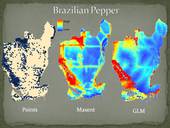Highlight
Predicting the Distribution of Invasive Species from Aerial Survey Data
Achievement/Results
The Quantitative Spatial Ecology, Evolution, and Environment (QSE3) IGERT is an NSF-funded program at the University of Florida that started in the Fall of 2008. QSE3 involves students and faculty from ten departments. Our program focuses on the critically important and conceptually unifying theme of spatial dynamics, covering topics such as evolution and spread of emerging pathogens; the causes and consequences of shifting species distributions; and conservation of species in patchy habitats. To tackle these issues, graduate students must acquire an arsenal of tools from the fields of mathematics, biology, geography, and statistics. In seeking to train scientists who embrace a new philosophy about quantitative tools, we also prepare individuals to speak to colleagues from different disciplines, and who can function as part of intellectually diverse teams by bringing different tools to bear on shared problems. To integrate our philosophy into practice each cohort is required to team with an outside client to define a research project, which may be peripheral to the students own research interests. These projects have ranged from collaborations with departments and faculty on campus to problems brought to us from outside organizations. The students work together formally in a workshop for an entire year on the project, and continue to work on manuscripts and offer presentations beyond their workshop year.
We are now in our third workshop year. For the past eight months, our third cohort of students have worked on an interdisciplinary research project to predict distributions of invasive species for the Nature Conservancy, the South Florida Water Management District, and the National Park Service. The external clients are monitoring (and attempting to control) invasive species in south Florida and the Everglades National Park System. Invasive species are disruptive to habitats and native species through this region, and the cost of managing Florida’s invasive plants alone is estimated at $100 million each year. The clients have been working together to develop monitoring systems to gather data on the locations and extent of several invasive species. They are interested in using these data in conjunction with environmental data to find covariates associated with invasions and to use the results to develop predictive maps of future expansions. The students are using a variety of species distribution models to predict invasions and to compare modeling techniques. They will develop models for five invasive plant species in the south Florida region, including Melaleuca, Australian Pine, Brazilian Pepper and Old World Climbing Fern.
The modeling techniques that they are using include MaxEnt, a method that is suitable for ‘presence only data’ (no absences in the data), Generalized Linear Models and boosted regression trees, a machine learning technique. The techniques vary in the quality of data required, the ease of use, and mathematical complexity. The covariates that have been developed as input into the models include land cover, climate variables (e.g., annual precipitation, minimum annual air temperature, and seasonality of precipitation), elevation, distance to development, distance to coast, and distance to canals. The students recently presented their results at the joint Florida Wildlife and Florida Exotic Pest Council Meeting in Ocala, Florida where they also met with their partners to discuss their current results and future research plans. They also plan to develop a dynamic mathematical model using integro-difference equations, which model the spread of species in continuous habitat over discrete time steps in simulated habitat environments.
Additional presentations are planned for the summer for the US-Africa Workshop on Quantitative Landscape Ecology and Environmental Sustainability at the University of KwaZulu-Natal, Durban, South Africa and at the Ecological Society of America, Portland, Oregon. The workshop will continue officially through summer 2012 and students will continue to work on the project throughout their PhD programs. Results of this project will inform future monitoring of species in south Florida and future control measures designed to reduce the presence and spread of these invasive species. The models are designed to be globally applicable as well, so that they may be used to predict future invasions in other areas and so contribute to monitoring and control in additional regions.
Address Goals
By working within their cohort as an integrative research team, our Fellows exemplify the education and training goals outlined by the NSF IGERT program. The fellows bring their individual disciplinary expertise to bear on a common problem that requires interdisciplinary approaches and therefore develop new integrative methods to the shared problem. The students also learn to navigate the challenges that often arise when applying their abstract knowledge to a practical problem, in a way that will serve the needs of a partner/client group. Students and faculty are using recent methods developed for modeling species distribution. The students will not only be contributing to advancements in the science of species distribution modeling by comparing techniques and critiquing results, but also will be contributing to the science of predicting the expansion of invasive species and providing valuable guidance to managers for controlling the spread. The modeling approaches the students develop can be used anywhere and may serve as a standard for evaluating the potential for invasive spread in other countries. By evaluating each of the techniques, the fellows will be contributing toward best practices for modeling habitat for invasive species.
The students who are in this workshop are developing skills that will bring them to the forefront of their field. In the case of the students in biology, they are developing excellent quantitative skills and learning to collaborate with statisticians and mathematicians to further their work in the field. Likewise, students in statistical and mathematical sciences are developing their skills to work on real world environmental issues and to understand the questions and vocabulary of the biological sciences. All fellows are enhancing their ability to work with members of interdisciplinary teams.






